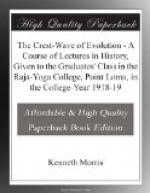The Chinese themselves are only homogeneous in race in the sense that Europe might be if the Romans had conquered it all, and imposed their culture and language on the whole continent. The staid, grave, dignified, and rather stolid northern Chinaman differs from the restless and imaginative Cantonese not much less than the Japanese does from either. This much you can say: Chinese, Japanese, and Coreans have been molded into a kind of loose unity by a common culture; the peoples of China into a closer homogeneity by a common culture-language, written and spoken,—and by the fact that they have been, off and on during the last two thousand years, but most of the time, under the same government. As to Corea, though in the days of Confucius it was unknown to the Chinese, the legends of both countries ascribe the founding of its civilization and monarchy to a Chinese minister exiled there during the twelfth century B. C. Japanese legendary history goes back to 600 B. C.;—that is, to the closing of the Age of the Mysteries, and the opening of that of the Religions:— I imagine that means that about that time a break with history occurred, and the past was abolished: a thing we shall see happen in ancient China presently. But I suppose we may call Shotoku Daishi the Father of historical Japan;—he who, about the end of the sixth century A. D., brought in the culture impetus from the continent. About that time, too, Siam rose to power; and soon afterwards T’ang Taitsong imposed civilization on Tibet.—So there you have the ‘Altaic’ Race; Altaic, as Mr. Dooley is Anglo-Saxon. To speak of them as ‘Mongolian’ or ‘Mongoloid,’ as is often done, is about as sensible as to speak of Europeans and Americans as ‘Hunnoid,’ because the Huns once conquered part of Europe. It conveys derogation—which Altaic does not.




